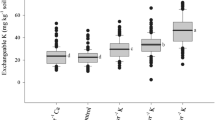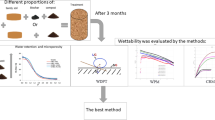Abstract
The effectiveness of four granular wetting agents to decrease water repellency in sandy soils of contrasting organic matter (OM) content and influences on kikuyugrass [Pennisetum clandestinum (Holst. Ex Chiov)] grown as turfgrass, were evaluated. A laboratory test assessed the wettability of two non-wetting soils (low OM, 4.7%; high OM, 17%) after treatment with granular soil wetting agents, with four being selected for field experimentation. A field experiment included two turfgrass ages (established from 20 week or 20 year old turfgrass in 2005; the latter included a 50 mm ‘mat’ layer and thus had high OM content in the surface soil), four granular soil wetting agents (plus a ‘nil’ as control), and five replicates. Surface soil (0–25 mm) water repellency, measured using the molarity of ethanol droplet test (MED), ranged from 0.4 M to 4.3 M during the irrigation season, and repellency was more severe in the soil with high OM (32%) content than low OM (8.6%) content. Soil wetting agents decreased the development of soil water repellency to varying extents, and maintained turfgrass quality; with improvement related to the amount of active ingredient applied. We recommend utilising an effective soil wetting agent, in combination with practices that limit the accumulation of soil OM, to decrease the severity and incidence of soil water repellency in turfgrass grown on sandy soils.





Similar content being viewed by others

Abbreviations
- DM:
-
Dry matter
- ET:
-
Evapotranspiration
- EC:
-
Electrical conductivity
- LSD:
-
Least significant difference
- MED:
-
Molarity of ethanol droplet
- OM:
-
Organic matter
- VWC:
-
Volumetric water content
References
Allen RG, Pereira LS, Raes D, Smith M (1998) Crop evapotranspiration−Guidelines for computing crop water requirements In: FAO Irrigation and Drainage Paper 56. Food and Agriculture Organization of the United Nations, Rome
Augustin BJ, Snyder GH (1984) Moisture sensor-controlled irrigation for maintaining bermudagrass turf. Agron J 76:848–850
Barton L, Colmer TD (2006) Irrigation and fertiliser strategies for minimising nitrogen leaching from turfgrass. Agric Water Manag 80:160–175
Barton L, Wan GGY, Buck RP, Colmer TD (2009a) Does N fertiliser regime influence N leaching and quality of different-aged turfgrass (Pennisetum clandestinum) stands? Plant Soil 316:81–96
Barton L, Wan GGY, Buck RP, Colmer TD (2009b) Effectiveness of cultural thatch-mat controls for young and mature kikuyu turfgrass. Agron J 101:67–74
Carrow RN, Johnson BJ, Burns RE (1987) Thatch and quality of Tifway Bermudagrass turf in relation to fertility and cultivation. Agron J 79:524–530
Carter DJ (2002) Water repellence. In: McKenzie N, Coughlan K, Cresswell H (eds) Soil physical measurement and interpretation for land evaluation. CSIRO Publishing, Collingwood, pp 85–89
Cisar JL, Williams KE, Vivas HE, Haydu JJ (2000) The occurrence and alleviation by surfactants of soil-water repellency on sand-based turfgrass systems. J Hydrol 231–232:352–358
Clothier BE, Vogeler I, Magesan GN (2000) The breakdown of water repellency and solute transport through a hydrophobic soil. J Hydrol 231–232:255–264
Dekker LW, Doerr SH, Oostindie K, Ziogas AK, Ritsema CJ (2001) Water repellency and critical soil water content in a dune sand. Soil Sci Soc Am J 65:1667–1674
Dekker LW, Oostindie K, Kostka SJ, Ritsema CJ (2005) Effects of surfactant treatments on the wettability of a water repellent grass-covered dune sand. Aust J Soil Res 43:383–395
Dekker LW, Ritsema CJ (1994) How water moves in water repellent sandy soil 1. Potential and actual water repellency. Water Resour Res 30:2507–2517
Dekker LW, Ritsema CJ, Oostindie K (2004) Dry spots in golf courses: occurrence, amelioration and prevention. Acta Hort 661:99–104
Doerr SH, Shakesby RA, Walsh RPD (2000) Soil water repellency: its causes, characteristics and hydro-geomorphological significance. Earth Sci Rev 51:33–65
Hallett PD (2008) A brief overview of the causes, impacts and amelioration of soil water repellency−a review. Soil Water Res 3:S21–S29
Harper RJ, Gilkes RJ (1994) Soil attributes related to water repellency and the utility of soil survey for predicting its occurrence. Aust J Soil Res 32:1109–1124
ICID/FAO (1996) Irrigation scheduling: from theory to practice. Proceedings of the ICID/FAO workshop on irrigation scheduling. ICID and FAO, Rome
Johnston KL (1996) Turf irrigation and nutrient study - Turf manual. Royal Australian Institute of Parks and Recreation, W.A. Region
Karnok KJ (2006) Which wetting agent is best? Golf Course Manage. July: 82−83 (available from www.gcsaa.org/GCM/july/pdfs/July06_BestWetting.pdf)
Karnok KJ, Tucker KA (2001) Wetting agent treated hydrophobic soil and its effect on color, quality and root growth of creeping bentgrass. Inter Turfgrass Soc Res J 9:537–541
King PM (1981) Comparison of methods for measuring severity of water repellence of sandy soils and assessment of some factors that affect its measurement. Aust J Soil Res 19:275–286
Kostka SJ (2000) Amelioration of water repellency in highly managed soils and the enhancement of turfgrass performance through the systematic application of surfactants. J Hydrol 231–232:359–368
Kostka SJ, Bially PT (2005) Synergistic surfactant interactions for enhancement of hydrophilicity in water repellent soils. Inter Turfgrass Soc Res J 10:108–114
Kundzewicz ZW, Mata LJ, Arnell NW, Döll P, Kabat P, Jiménez B, Miller KA, Oki T, Sen Z, Shiklomanov IA (2007) Freshwater resources and their management. In: Parry ML, Canziani OF, Palutikof JP, van der Linden PJ, Hanson CE (eds) Climate change 2007: impacts, adaptation and vulnerability. Contribution of working group II to the fourth assessment report of the intergovernmental panel on climate change. Cambridge University Press, Cambridge, pp 173–210
Landschoot PJ, Mancino CF (2000) A comparison of visual vs. instrumental measurement of color differences in bentgrass turf. HortSci 35:914–916
Leinauer B, Karcher D, Barrick T, Ikemura Y, Hubble H, Makk J (2007) Water repellency varies with depth and season in sandy rootzones treated with ten wetting agents. Appl. Turfgrass Sci. http://plantmanagementnetwork.org/pub/ats/research/2007/repel/. Accessed 24 August 2010
Letey J (1969) Measurement of contact angle, water drop penetration time, and critical surface tension In: Debano LF, Letey J (eds) Symposium on water-repellent soils. University of California, pp 43−47
Lyons EM, Jordan KS, Carey K (2009) Use of wetting agents to relieve hydrophobicity in sand rootzone putting greens in a temperate climate zone. Inter Turfgrass Soc Res J 11:1131–1138
Mane S, Moore D, Moore RA (1993) A simple method for determining the initial and residual effectiveness of soil wetting agents. Inter Turfgrass Soc Res J 7:485–488
McArthur WM, Bettenay E (1960) Development and distribution of soils of the Swan Coastal Plain, Western Australia. Soil Publication 16, revised 1974. CSIRO, Melbourne
McGhie DA, Posner AM (1981) The effect of plant top material on the water repellence of fired sands and water repellent soils. Aust J Ag Res 32:609–620
Miller RH, Wilkinson JF (1977) Nature of the organic coating in sand grains of nonwettable golf greens. Soil Sci Soc Am J 41:1203–1204
Mitra S, Vis E, Kumar R, Plumb R, Fam M (2006) Wetting agent and cultural practices increase infiltration and reduce runoff losses of irrigation water. Biologia 61(suppl 19):S353–S357
Miyamoto S (1985) Effects of wetting agents on water infiltration into poorly wettable sand, dry sod and wettable soils. Irrig Sci 6:271–279
Oostindie K, Dekker LW, Wesseling JG, Ritsema CJ (2008) Soil surfactant stops water repellency and preferential flow paths. Soil Use Manage 24:409–415
Park DM, Cisar JL, Williams KE, Snyder GH (2004) Alleviation of soil water repellency in sand based bermudagrass in South Florida. Acta Hort 661:111–115
Pathan SM, Alymore LAG, Colmer TD (2003) Properties of several fly ash materials in relation to use as soil amendments. J Environ Qual 32:687–693
Payne RW, Murray DA, Harding SA, Baird DB, Soutar DM (2009) GenStat for Windows (12th Edition) Introduction. VSN International, Hemel Hempstead
Ritsema CJ, Dekker LW (1996) Water repellency and its role in forming preferred flow paths in soils. Aust J Soil Res 34:475–487
Roberts FJ, Carbon BA (1972) Water repellence in sandy soils of south-western Australia. II. Some chemical characteristics of the hydrophobic skins. Aust J Soil Res 10:35–42
Short DC (2002) Irrigation requirements and water-use of turfgrasses in a Mediterranean-type environment. Dissertation, University of Western Australia
Short DC, Colmer TD (2007) Development and use of a variable-speed lateral boom irrigation system to define water requirements of 11 turfgrass genotypes under field conditions. Aust J Exp Agric 47:86–95
Soldat DJ, Lowery B, Kussow WR (2010) Surfactants increase uniformity of soil water content and reduce water repellency on sand-based golf putting greens. Soil Sci 175:111–117
Täumner K, Stroffregren H, Wessolek G (2005) Seasonal dynamics of preferential flow in a water repellent soil. Vadose Zone J 5:405–411
USDA (1992) Keys to soil taxonomy. Pocahontas Press, Blacksburg
Wallis MG, Horne DJ (1992) Soil water repellency. Adv Soil Sci 20:91–146
Acknowledgements
Leon Hodgson for implementing the field-based study, maintaining the turfgrass plots, and collecting soil and plant samples. George Wan and Matthew Willis for plant and soil analyses. Greenacres Turf Farm is thanked for help in the design and maintenance of the irrigator. City of Stirling and City of Perth for providing apprentices to assist with mowing, CSBP Ltd for supplying fertiliser, M.E.Y. Equipment for lawn mower supply and servicing, Turf Developments WA for renovating the turfgrass plots, and UWA (UniGrounds) for assistance with some aspects of general turfgrass maintenance. Members of the UWA Turf Industries Research Steering Committee for their support and advice. Comments made by Margaret Roper and three anonymous reviewers improved the manuscript. This project has been facilitated by Horticulture Australia Ltd in partnership with the Australian turf industry. It was funded by voluntary contributions from a consortium of local government authorities, plus the Botanic Gardens and Parks Authority, Department of Education, Department of Water, Golf Course Superintendent Association of Western Australia, Lawn Doctor, Organic 2000, Turf Grass Association of Australia (WA), and the Western Australian Turf Growers Association.
Author information
Authors and Affiliations
Corresponding author
Additional information
Responsible Editor: Alain Pierret.
Rights and permissions
About this article
Cite this article
Barton, L., Colmer, T.D. Granular wetting agents ameliorate water repellency in turfgrass of contrasting soil organic matter content. Plant Soil 348, 411–424 (2011). https://doi.org/10.1007/s11104-011-0765-3
Received:
Accepted:
Published:
Issue Date:
DOI: https://doi.org/10.1007/s11104-011-0765-3



